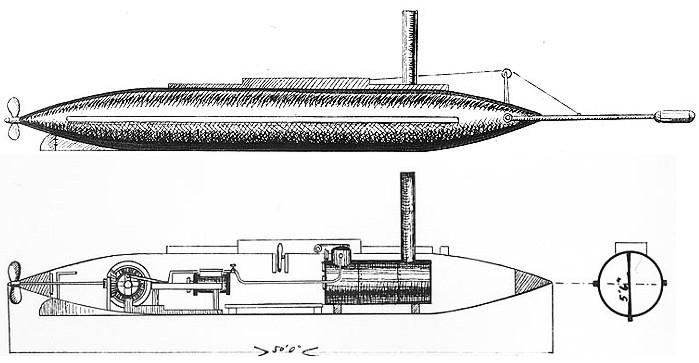
During the American Civil War, military innovations skyrocketed with modernization, including the use of the torpedo. One of the first recorded uses of the torpedo in the United States occurred in 1778 during the Battle of Kegs. Inventor David Bushnell released kegs of explosive gunpowder that would explode when in contact with a ship into the Delaware River to act as mines to disrupt the British Royal Navy. After the American Revolution, engineer Robert Fulton pushed the sale of the torpedo to the United States in 1807 to show President Thomas Jefferson new advancements in naval technology. After failing to make a sale with the Jefferson administration, Fulton returned to the United States in 1810 to show the newly elected James Madison the new weapon's power. Impressed, Madison allowed Fulton to display the torpedo to Congress in hopes of adding it to the American arsenal. Congress authorized the torpedo purchase and later used the new weapon against the Royal Navy during the War of 1812. To advance naval warfare further, engineers invented a vessel that could carry the torpedo into battle, known as the torpedo boat. The first time the new ship witnessed action was during the American Civil War.
In the first year of the war, President Abraham Lincoln ordered a blockade of southern ports to prevent foreign goods and food from entering the Confederacy. Since the Union's navy was more extensive and powerful, the Confederate Navy began working on a new type of naval warfare that included small armored ships. By the start of the conflict, the South invented the first American torpedo boat. Naval engineers designed the small cigar-shaped vessel to be fast and carry loaded torpedoes into battle against large enemy ships. Due to its construction, the iron sides, and the sharp bow used for ramming, the vessel became a deadly weapon in asymmetrical warfare. The Confederate Navy produced multiple classes and innovations of torpedo boats throughout the war, including adding spars and making the vessel semi-submersible.

One of the most well-known torpedo boat classes is the David Class, launched in 1863. Designed by St. Julien Ravenel, the CSS David was operated by four men and was equipped with a long spar on the bow containing one hundred and thirty-five pounds of gunpowder. David worked at night and below the surface to keep the spar safe from enemy sight, making the vessel similar to a submarine. On the night of October 5, 1863, CSS David participated in a battle against USS New Ironsides in Charleston, South Carolina. Captained by Lieutenant William T. Glassell, David left Charleston Harbor under the protection of the night and approached the ironclad steamer New Ironsides. Located only fifty yards out, the federal crew spotted the David; due to its proximity and speed, New Ironsides was left paralyzed by the incoming attack. The David charged and detonated the spar directly underneath the starboard of the ironclad steamer. Upon the initial detonation, a large seawater column landed on the David, extinguishing the boiler fire and immobilizing the vessel. With the engine believed to be dead, many crews abandoned the ship, fearing it was sinking.
An assistant engineer managed to save the ship by restarting the fire in the boiler and fueling the engine. In doing so, the torpedo boat could successfully sail safely away from the slightly damaged New Ironsides. The Confederate Navy continued to produce torpedo boats like the CSS Albemarle until the end of the war in 1865. Overall, the design of the David class had many flaws, including exposed boilers and misfires. Union torpedo boats faced similar technical issues but were more successful in innovation with the USS Spuyten Duyvil. It was not until after the American Civil War that the self-propelled torpedo was invented, and naval warfare changed drastically.


